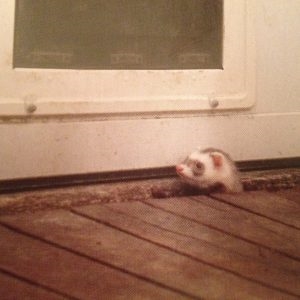Ferret-Proofing Your Home
This Critical Ferret Care Tip Can Help Keep Your Ferret Safe
A ferret’s cage is her or his primary home, but they don’t want to spend all their time in there. But when ferrets are let loose in the house, they can get into a lot of trouble!
From the moment your new fuzzy family member arrives, your home should be ferret-proofed.
Your home is a scary, yet stimulating jungle to a tiny ferret. Their thin, flexible bodies can get into all kinds of small spaces. They love to crawl under and behind things and even burrow into things– like sofa cushions and laundry. They can get stuck in heating vents and openings near pipes under the sink. Once a ferret finds a tunnel-like place to explore, you may have a very difficult time finding her.
It’s important to plan in advance where you will let your ferret explore–one small room, a section of the house? The larger the area, the more ferret-proofing it will require. Most areas can’t be completely ferret-proofed, but it is your responsibility to keep him out of harm’s way. He depends on you to stay vigilant at all times to keep him safe.
Some General Guidelines for Ferret-Proofing Your Home
1. Put up security gates where needed
If an off-limits area doesn’t have a secure door you may need to construct your own gate. It should be at least 3 feet high and made of something smooth that ferrets can’t easily climb, such as wood or plexiglass. Don’t expect dog gates or children’s gates to do the trick. Ferrets see these as fun ladders.
2. Don’t forget ferrets can not only climb but can jump
You should ferret-proof anything that is under about 30 inches from the ground or 30 inches from any place you ferret can reach by climbing or jumping. For instance, she may not be able to climb or jump directly onto your desk, but she may be able to climb up onto the chair and then leap up from there!
3. Don’t store medications, cleaning supplies or other chemicals in accessible places
Even over-the-counter medications, along with cleaning supplies can be toxic to ferrets.
4. Watch what you leave lying around
Any object can be a toy or chew toy to a ferret– pen caps, rubber bands, plastic bags, cotton swabs, erasers to name a few. Small items or chewed off pieces can be digested and cause life-threatening conditions such as intestinal blockage.
Dangers Lurk in Every Room
Appliances
The laundry room and kitchen should be kept off-limits. These rooms are practically impossible to ferret-proof and are filled with dangers, such as getting stuck behind or shut in large appliances, ingesting chemicals or fiberglass insulation, and appliance fans that can turn on and injure or kill your ferret.
Small Openings
Before you let him run free, do your best to block up all small openings. This is an essential step in ferret-proofing your home. Make sure all cabinets, drawers, and doors are closed tight and there are no large gaps. If cabinet doors do not close securely, you may need to attach child-proof locks (one of my ferrets, Panda, loved to open cabinet and closet doors. She would lay down on her side and scratch at the bottom corner of the door until it opened). Check to be sure he can’t get into cabinets from under the ledges. Check for any openings or holes that could lead into the walls or to the outside. If any opening beneath a door or window is more than an inch, your ferret may try to squeeze underneath. Floor vents and air returns are also dangerous. Even if he can’t fit through them, he may be able to pull them off if they are not secured tightly.
Cords
Electrical cords are often seen as chew toys for ferrets. The best solution is to keep them out of reach or to enclose them in special cable or cord covers. If that is not doable, you could try wrapping the cords in aluminum foil. Ferrets generally don’t like chewing on foil.
Furniture
Ferrets can easily be crushed in furniture. Rockers, recliners and fold-out furniture are especially dangerous because of their moving parts. Since you can’t really ferret-proof furniture, it’s best not to use this type of furniture when your ferret is out playing. But a ferret can get under or behind a chair or sofa cushion and get sat on easily, as well. It is important to always know where your ferret is before you sit down.
Besides tunneling in furniture, ferrets also love to dig holes in the thin fabric under sofas, chairs, and mattresses. They can then get up into the furniture. If your ferret ingests foam or stuffing, an intestinal blockage can occur.
Sinks, Toilets and Bathtubs
Although ferrets can swim, and often enjoy it, they can get tired and drown. Therefore, it is important to be sure the toilet seat is kept down and there is no standing water in the sink or tub.
Trash Cans
Be sure to keep all wastebaskets and trash cans out of reach. An unlimited amount of potential hazards can be found in the trash. If it is not possible to remove the trash cans, covering them with a weighted lid is an option.
Fans and Fireplaces
Fireplaces can be quite intriguing to ferrets and need to be blocked off. You can invest in a heavy-duty screen that ferrets can’t climb and that can be pushed flush against the fireplace.
Floor fans should be removed, or at least unplugged. Fans can easily injure or kill a ferret if he gets too close.
Potted Plants
You may also want to remove potted plants. Not necessarily a danger (unless the plant is poisonous), but ferrets love to dig in the dirt (Panda, loved to dig in the large potted plants in the living room. When she saw me coming she would freeze–holding perfectly still so I wouldn’t notice her)!
Where Did She Go?
Even with diligent ferret-proofing, your ferret can still find a spot you missed or didn’t think she could get to. If your ferret does disappear, you may try using a favorite squeaky toy to coax her out. Or, if she likes a certain food and comes out when you eat it (Panda loved ice cream and somehow always knew when I was eating it and came running!), you could try that. Giving her a treat when she comes out as a reward will encourage the behavior.
Following these ferret care tips to ferret-proof your home will give you peace of mind, knowing you have done your best to keep your little one safe.




It is so cute but we should do a lot of things to keep it safe ,but at the end it is kids fan and they love it.good luck
Yes, they can be quite a handful!
Great advice for us ferret lovers! I can relate to the gate scenario, one of our ferrets almost got her head stuck between bars once, pretty scary. We always make sure we have all the other doors closed too, so it really is ferret proof! That way we can keep an eye on them a lot easier.
Thanks for your kind comment, Craig! It is so important to protect our fearless ferrets! If you are interested in ferret-proof gates and playpens, I have recently posted a “Prevue Pet Products Playpen Review”. Check it out.
I would love to have one running around but it’s illegal in California ?